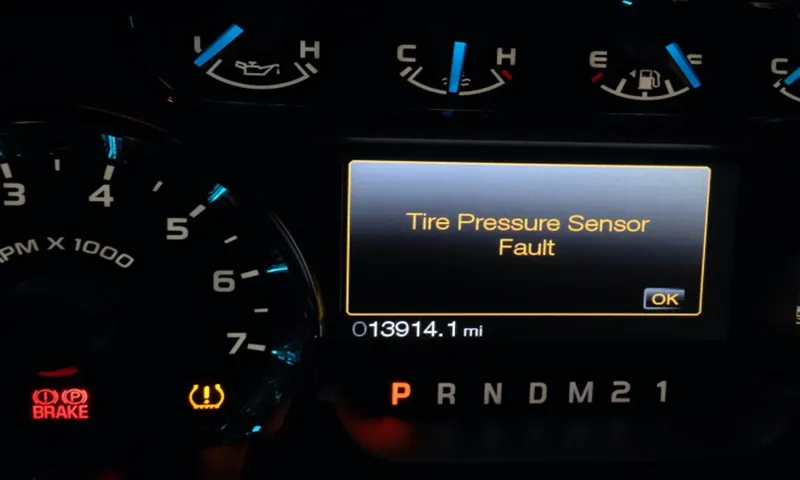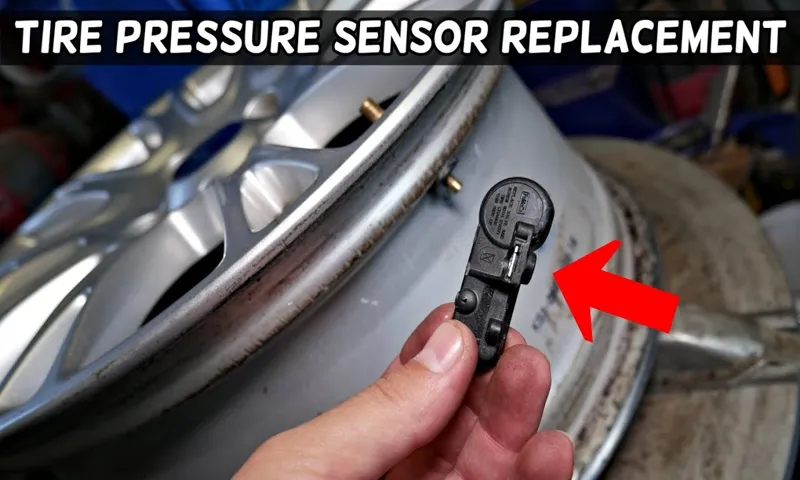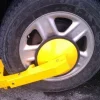Do you ever get that pesky tire pressure light popping up on your dashboard? It can be annoying, especially if you’re not sure how to fix it. Don’t worry – resetting your tire pressure sensor is easier than you might think! With just a few simple steps, you can get that light to disappear and feel confident that your tires are properly inflated. In this guide, we’ll take you through the process of resetting your tire pressure sensor step-by-step so that you can get back on the road knowing that your vehicle is operating at its best.
Whether you’re a seasoned driver or a newbie, this guide has got you covered. So let’s get started!
Table of Contents
Understanding Tire Pressure Sensor
If you’re wondering how to reset your tire pressure sensor, don’t worry, it’s easier than you might think. First, you need to locate the reset button on your vehicle. This button is typically located in the glove box or under the steering wheel.
Once you find the reset button, turn on the car and press and hold the button for a few seconds until the tire pressure light on your dashboard starts flashing. Release the button and wait for the light to go off, indicating that the sensor has been reset. It’s important to note that if your tire pressure is still low after resetting the sensor, you may need to check for any leaks or punctures in your tires.
Maintaining proper tire pressure is essential for the safety and performance of your vehicle, so be sure to check it regularly and reset the sensor when necessary.
What is a Tire Pressure Sensor?
A tire pressure sensor is a small electronic device that is installed in your vehicle’s tires to monitor air pressure levels. These sensors use various measurement techniques to keep track of the pressure, and they provide real-time updates to the driver via the dashboard or tire pressure monitoring system. The primary function of these sensors is to ensure that your tires have sufficient air pressure at all times.
Low tire pressure is not only dangerous but can also increase fuel consumption and reduce tire life. Therefore, it is essential to regularly check your tire pressure and inflate them to the recommended levels. Installing a tire pressure sensor can greatly aid this process and give you added peace of mind, knowing that your tires are at the correct pressure.

How does it Work?
Tire Pressure Sensor Have you ever wondered how your car can detect if the pressure in your tires is too low? It’s all thanks to the tire pressure sensor. This clever gadget is mounted inside each tire and uses advanced technology to constantly monitor the air pressure. When the pressure drops below a certain level, the sensor sends a signal to the car’s onboard computer, which in turn alerts the driver by illuminating a warning light on the dashboard.
This not only helps to prevent accidents but can also improve fuel efficiency and prolong the lifespan of your tires. So next time you see that little warning light, don’t ignore it – take action and make sure your tires are properly inflated.
Why Reset Tire Pressure Sensor?
Reset Tire Pressure Sensor Have you ever been driving down the road and noticed a warning light on your dashboard come on? It could be your tire pressure sensor alerting you that one or more of your tires is running low on air. But why reset the tire pressure sensor? It’s a common question that many drivers ask. Understanding the purpose of the tire pressure sensor is crucial to maintaining the health of your vehicle.
Essentially, the sensor is responsible for monitoring the air pressure in your tires. When it detects that the air pressure has dropped below the recommended levels, it sends a signal to your vehicle’s computer, which then activates the warning light on your dashboard. Resetting the tire pressure sensor is necessary if the recommended levels have been restored or if the sensor is malfunctioning.
Remember, keeping your tires inflated to the proper levels is not only essential for safe driving, but it can also improve fuel efficiency and extend the life of your tires. So, next time you see that warning light, make sure to check your tire pressure and reset the sensor if necessary.
Steps to Reset Tire Pressure Sensor
If you’re wondering how to reset your tire pressure sensor, don’t fret – it’s not as complicated as it may seem! First, locate the reset button on your dashboard. It’s usually labeled “TPMS” or “Tire Pressure,” and may be located on the center console or steering wheel. Turn your ignition switch to the “on” position, but don’t start the car.
Hold down the reset button until the TPMS light on your dashboard blinks slowly. Release the button, and wait for the light to flash rapidly. This indicates that the sensor has been reset.
Finally, check your tire pressure with a gauge to make sure it’s within the recommended range. By resetting the sensor, you’ll ensure that it’s accurately reading the pressure in your tires, which will help keep you safe on the road.
Step 1: Check the User Manual
If you’re experiencing issues with your tire pressure sensor, the first step is to check the user manual. Different car models have different methods of resetting the sensor, so it’s important to consult the manual before attempting any troubleshooting. Once you have the manual, look for the section on tire pressure monitoring systems.
It should include directions for resetting the sensor and troubleshooting tips for common issues. If you’re still having trouble after following the manual’s instructions, it may be time to take your vehicle to a professional mechanic or dealership. Remember, proper maintenance of your tire pressure sensor can extend the life of your tires and improve your car’s overall performance.
Step 2: Inflate your Tires
Having the tire pressure sensor light come on in your car can be quite alarming, but resetting it can be a breeze if you follow the necessary steps. One of the essential steps to reset your tire pressure sensor is to inflate your tires accordingly. Ensure to check your car owner’s manual for recommended tire pressure levels for your particular vehicle.
For instance, if your recommended pressure level is 30 psi, you may need to fill the tire up to 32 psi to compensate for the drop when you attach the tire pressure gauge. You can use a tire pressure gauge to check each tire’s pressure and fill up any that are low. Once all tires are set to their recommended levels, check that the tire pressure sensor light has gone off and reset it if necessary.
Simple steps like tire inflation and adjustment will ensure your car keeps running smoothly and keep you safe on the road.
Step 3: Locate the Reset Button
When it comes to resetting your tire pressure sensor, Step 3 is a crucial component. You’ll need to locate the reset button, which can typically be found within the glove compartment or under the steering wheel. The button is often small and inconspicuous, so it’s essential to look closely.
Once you find it, hold it down for a few seconds until the tire pressure light blinks or beeps. This signals that the sensor has been successfully reset. Keep in mind that not all vehicles have a reset button, so refer to your owner’s manual for instructions specific to your make and model.
With a little patience and attention to detail, you can get your tire pressure sensor functioning as good as new and ensure a safer, smoother ride on the road.
Step 4: Press and Hold the Button
Reset tire pressure sensor When it comes to resetting the tire pressure sensor on your car, step four is crucial. After you’ve turned your car on and located the reset button, it’s time to press and hold it down. This step typically takes around 10 seconds, but it’s important to follow the manufacturer’s instructions for your specific vehicle.
Holding the button down will initiate the reset process and clear the sensor’s memory of any previous pressure readings. Once the process is complete, you’ll notice that the tire pressure warning light on your dashboard will turn off. It’s important to note that if the light doesn’t turn off, there may be an issue with the sensor or your tires that needs to be addressed.
Overall, resetting your tire pressure sensor is an easy process that can save you money in the long run by preventing unnecessary wear and tear on your tires.
Step 5: Wait for the Indicator Light to Blink
Reset Tire Pressure Sensor Resetting your tire pressure sensors is crucial to maintain the optimal performance of your vehicle. After checking and adjusting the tire pressure, you must reset the sensor system to ensure its proper functioning. The final step in resetting your tire pressure sensor is to wait for the indicator light to blink.
Once you’ve reset your tire pressure monitoring system (TPMS), the light will blink for about one to two minutes as your vehicle’s computer recalibrates the sensors. This indicator light will turn off once the TPMS is done recalibrating and your system is reset. Waiting for this light to signal that the system is recalibrating is essential, so don’t rush the process.
It could take longer depending on your vehicle, but make sure to give it enough time to reset. Once the light stops blinking, you’ll be confident that your tire pressure sensor system is accurately calibrated and ready to keep you safe on the road.
When to Visit Your Mechanic
If you’ve ever encountered a tire pressure sensor warning light on your dashboard, you might be wondering how to reset it. Resetting the tire pressure sensor is relatively easy and can be done without visiting a mechanic. Firstly, ensure that the tire pressure is at the recommended level and then drive your car for around ten minutes.
This will allow the sensors to reset automatically. If the tire pressure warning still persists, it’s possible that there is a fault with one of the sensors or the monitoring system. In this case, it’s best to visit a mechanic to identify and fix the issue.
It’s important to note that tire pressure plays a vital role in the handling, stability, and overall safety of your vehicle. Therefore, always ensure that your tires are inflated to the recommended pressure, and if you encounter any warning signs, don’t hesitate to seek the appropriate help.
If the Problem Persists
When to Visit Your Mechanic If you’re experiencing car trouble and your DIY fixes aren’t working, it may be time to take your vehicle to a mechanic. But how do you know when you’ve reached that point? If the problem persists despite your efforts, it’s time to call in the pros. This is especially true if you’re noticing strange sounds, smells, or movements when driving.
These can be signs of more serious issues that require professional attention. Additionally, if you’re not a trained mechanic, you may not have the expertise required to diagnose the issue properly. Putting off a visit to the mechanic can lead to bigger, more costly problems down the line.
Don’t wait until it’s too late – take your car to a mechanic at the first sign of trouble. Your mechanic can provide a diagnosis and fix the issue quickly, saving you both time and money in the long run. So, if you’re unsure of what to do next, trust your instincts and take your car to a mechanic – they’ll get you back on the road in no time.
Conclusion
Resetting your tire pressure sensor is easier than finding a needle in a haystack. With the right tools and a little know-how, you’ll be able to deflate any issues you may be having with your tire pressure sensor. So don’t be caught flat-footed and get rolling with a properly calibrated sensor today!”
FAQs
What is a tire pressure sensor?
A tire pressure sensor is a device that measures the air pressure in a vehicle’s tires and sends that information to the car’s computer.
Why is it important to reset your tire pressure sensor?
It is important to reset your tire pressure sensor to ensure that it is accurately measuring your tire pressure. If it is not reset properly, it may display incorrect readings which could lead to unsafe driving conditions.
How often should you reset your tire pressure sensor?
You should reset your tire pressure sensor anytime you add or remove air from your tires or if you have recently had your tires replaced. It is also recommended to reset your sensor once a month to ensure it is functioning properly.
Can you reset your tire pressure sensor yourself?
Yes, you can reset your tire pressure sensor yourself. The methods will vary depending on the make and model of your vehicle, but it can usually be done using the car’s dashboard controls or a handheld tool.
What are the common symptoms of a malfunctioning tire pressure sensor?
Common symptoms of a malfunctioning tire pressure sensor include a warning light on the dashboard, incorrect tire pressure readings, and stiffer steering.
How much does it cost to replace a tire pressure sensor?
The cost of replacing a tire pressure sensor can vary depending on the make and model of your vehicle and where you go for the repair. On average, it can cost anywhere from $50 to $250 per sensor.
Can a tire pressure sensor be repaired instead of replaced?
Yes, a tire pressure sensor can sometimes be repaired instead of replaced. If the issue is a simple fix, such as replacing a dead battery, a repair may be possible. However, if the sensor is damaged or malfunctioning beyond repair, it will need to be replaced.



